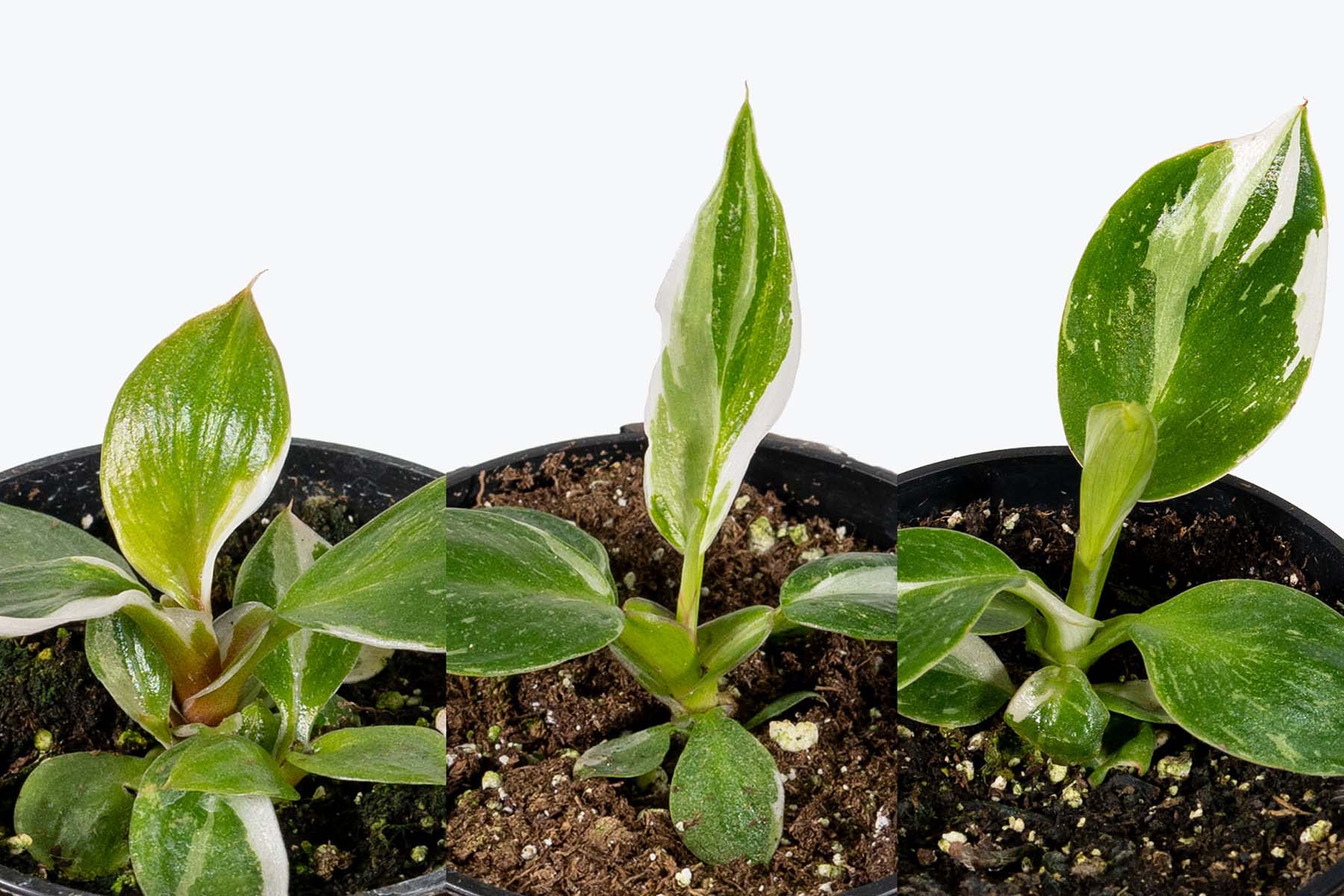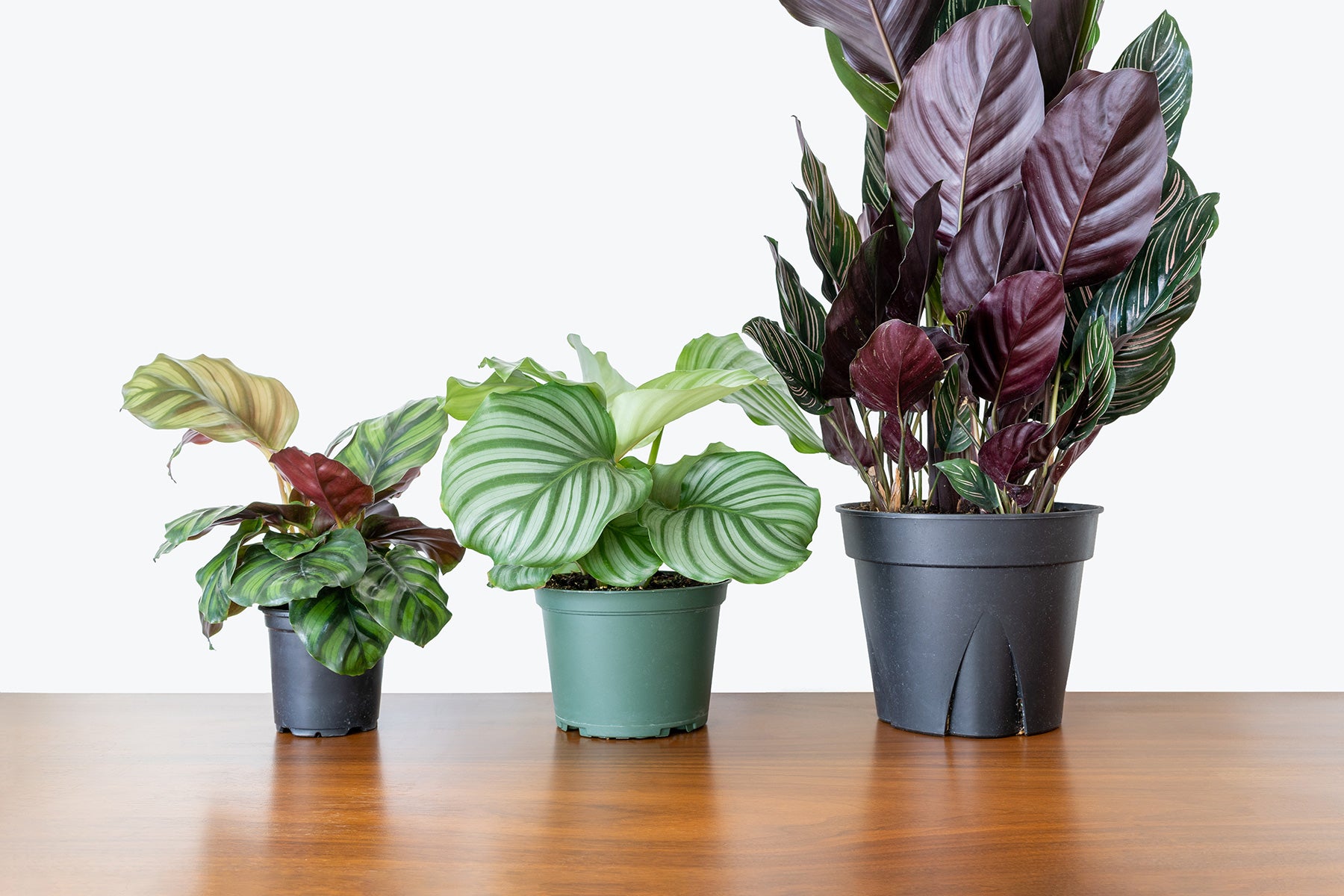
Plant Breakdown: The Difference Between the Philodendron White Princess, White Wizard & White Knight
The Philodendron genus, which belongs to the Araceae family, is native to tropical America and has over 400 species in it, so it only makes sense that with so many varieties, there are bound to be similarities amongst them. To the untrained eye, the Philodendron White Princess, Philodendron White Knight, and Philodendron White Wizard are prime examples of this as it can be a little difficult to distinguish between them. Known as the Triple Crown in the houseplant community, all three varieties have similarly shaped green leaves with white markings, as well as a similar growth pattern, but how are they different?

To answer that question, you have to take a more in-depth look at each plant, breaking down the type of variegation and the slight differences between them. If you are unsure as to which plant you have, or which plant you are looking for, the answer often comes down to the stem, while also considering leaf shape and variegation style. It would be best to do this analysis with slightly more mature specimens since the juvenile stages of all three of these plants tend to be quite similar, which is how they are typically sold. Additionally, it would be much easier to do this when you have all three plants side-by-side right in front of you but that’s exactly what this guide is for!
Let's break down each variety, based on colouring, variegation type, leaf shape, and more:
Philodendron White Princess
Known as the sister plant to the Philodendron Pink Princess, the Philodendron White Princess has probably been the most widely available variety of the Triple Crown. This is due in part to its proximity to the Pink Princess and the fact that it grows and looks very similar to her. With a slightly more compact growth habit, the White Princess has longer and slightly thinner leaves than the other two varieties. As the plant matures, these leaves may become more rounded but they will always remain a bit pointer. When it comes to colouring, its variegation is mostly white and typically splashy but there can be patches as well, leaving an intricate design unique to each leaf.
🎀
The best thing about the White Princess Philodendron is that it may surprise you with a rare patch of pink on the foliage every now and then if the growing conditions are ideal, or an almost fully white leaf!
To seal the deal on whether you have a White Princess Philodendron or not, check out the stem of your plant - if it is a White Princess, it will have bright green stems along with some pink and/or white colouring. Another hint would be to look at the cataphylls of your plant, which are modified leaves Philodendrons produce that surround and protect the newly forming leaves on the stems (i.e. the leaf casings). On the White Princess, these will also be a mix of white, pink and green, taking on a candy cane-like effect when looking at the stem up close. Since this is the only variety that can produce such a vibrant pink, you should be able to spy one of these beauties from far away!
Philodendron White Wizard
Next up: the Philodendron White Wizard. This is probably the least known of the trio based on the fact that it has been the most difficult to find. The Wizard is a climber, meaning it would appreciate a moss pole, such as our JOMO Extendable Moss Pole, or some sort of natural structure to latch onto in order to produce its characteristically large leaves. It is also the fastest-growing variety, developing the biggest and roundest leaves, so it should be quite easy to spot! As for its colouring, the bright green leaves may develop white variegation that typically presents as large patches, otherwise known as sectoral variegation, and is very rarely speckled or splashy, making a stark and striking contrast.
💚
You will also find that this variety has the least amount of consistent variegation, sometimes producing only green leaves, but when it does occur it makes a big impact.
To identify a true Philodendron White Wizard, check out the stems of your plant. There will never be any colour other than green and white present on the Wizard so if you see any pink, burgundy, or brownish-purple anywhere, you are looking at one of the other varieties! The completely green stems will sometimes be edged in white or contain stripes of white variegation on the stem itself, even the cataphylls could have some white on them, but no other colours should be present. Even though it has the least amount of colouring, in both variegation and variety of colours, every white patch that the Wizard produces will make quite the bold and beautiful statement.
Philodendron White Knight
Last, but certainly not least, is the Philodendron White Knight. This variety produces the most amount of colouring as compared to the other two, primarily on the stems. The dark purple stems create a strong contrast against the vibrant green leaves with their white variegation. Although the stems may present as more burgundy in colour sometimes, in either case, they will not be green, meaning you will definitely be able to tell if you have a White Knight over a Princess or Wizard. The White Knight is also a climber, with the proper support of course, and as it climbs, the purple stems and petioles (the portion of the plant that attaches the leaf to the stem) will develop and there may even be white on the cataphylls!
While your plant climbs, it will produce larger and larger leaves that have more of a rounded shape than the White Princess but smaller than the White Wizard. Each leaf may produce variegation as well but the type of variegation will come down to the genetics of your individual plant, along with the growing conditions and care routine. Be prepared to have some slightly inconsistent variegation but you can also expect to have a lot of variety when the variegation does occur. There can be huge patches of white, sometimes splashy or constellation-like patterns, or your plant could alternate between putting out all-white or all-green leaves, you will never know what’s coming next! A houseplant that keeps you on your toes has got to be the best plant out there.
Triple Crown Care Guide
Lighting:
Although Philodendrons can tolerate most light levels, you will want to keep these three varieties in lots of bright, indirect light to encourage the most amount of variegation. The brighter the light your plant receives, the more full and compact your plant will remain, with large foliage and minimal spacing in between the leaves on each vine. The majority of them are also relatively slow growers, so lower light will lead to even slower growth.
Watering:
In the spring/summer months, water your plant fully when the soil is half dry, but in the winter months, water your plant when the soil is almost completely dry. Most Philodendrons will not tolerate too much water, so avoid keeping the soil overly moist or soggy.
Humidity:
Most Philodendrons are quite low-maintenance, not requiring constant attention and the majority of light levels. This also includes their humidity needs, where they can live in average home humidity conditions and are fairly hardy. That being said, they will always appreciate some humidity, so mist your plant daily or keep them around a humidifier.
Fertilizing:
They make it very simple, fertilize with a balanced liquid fertilizer, or something like an Organic Liquid Plant Food, throughout the growing season (i.e. May - August).
Toxicity:
Since they are mildly toxic to both humans and pets, due to the calcium oxalate crystals that all parts of the plant contain, Philodendrons, like all other aroids, are best kept away from inquisitive children and animals.
Propagating:
Although they can be propagated, just remember that they are slow growers, so be patient. The best way to propagate would be by water propagation or soil propagation. Use clean sheers to snip off a vine, with at least 2 leaves, and remove the leaf on the node closest to the cut end, unless there is already an exposed node or aerial root. This node will be placed in the soil or water, as that is where the new roots will grow from. Then, wait for roots to form! With these cuttings, you can either make the original plant more full or you could start a whole new plant.
Now that you know the differences, check out our Philodendron White Knight, Philodendron White Wizard, and Philodendron White Princess offerings today to fill in the missing pieces of your own Triple Crown. Discovering you have one variety when you thought you had another is not the end of the world, as they are all extremely beautiful, but once you know the differences, you will be able to point out one from the other anywhere you go!









